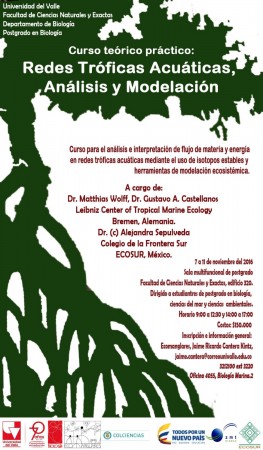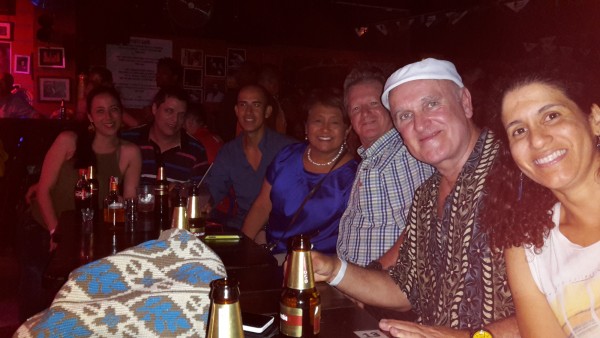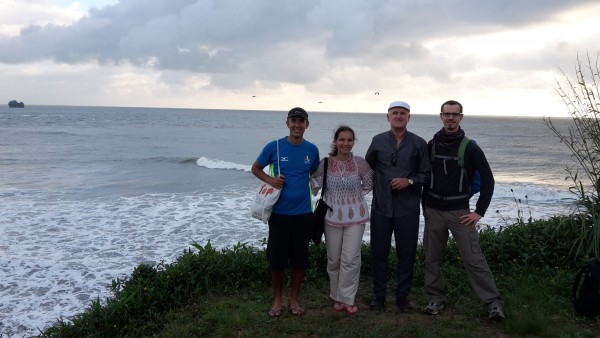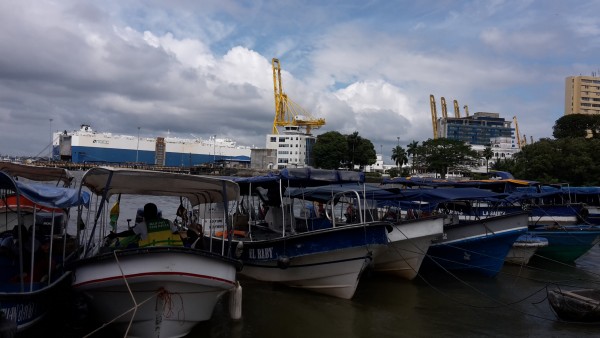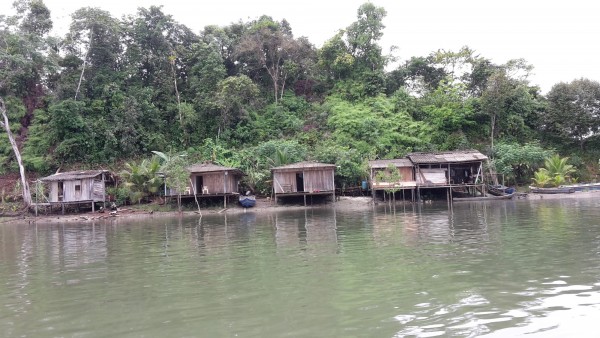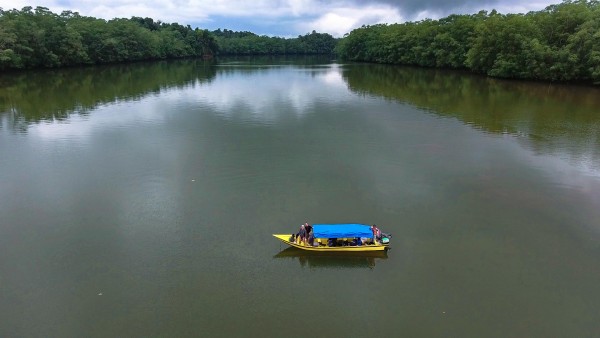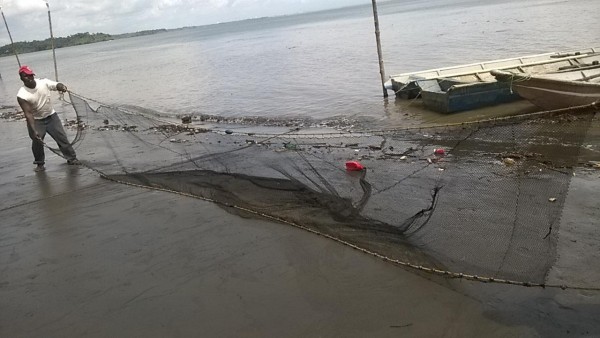Dieser Text ist zur Zeit nur auf Englisch verfügbar...
Last week we came back from our Ecopath with Ecosim (EwE) and stable isotope course and expedition to the Pacific coast of Colombia. We, - that is Gustavo Castellanos, Moritz Stäbler, Alejandra Sepúlveda and myself-, had a great and intensive time and shall report here briefly. Our activities were part of the Alexander von Humboldt project of Gustavo entitled ”Understanding and valuing mangrove ecosystem function and services in the Panama Bight eco-region“ which is associated to a project of the ECOMANGLARES group of Prof. Jaime Cantera of the Universidad del Valle entitled: “Análisis de la dinámica trófica de los manglares del Pacífico Colombiano mediante el uso integrado de isótopos estables y modelación ecosistémica: importancia para la producción pesquera del sistema”.
17.11.16
After having an enjoyable day in Cali with Pilar, who showed us around the town, we left Cali in the evening via a direct flight to Amsterdam-Bremen, where we arrived Friday in the early evening. After the great experience with the course and the field trip, and after being received with such a warm hospitality, excitement continues.
16.11.16
In the morning we traveled back to Buenaventura and visited the main fish market, which showed an enormous diversity and richness of fish and invertebrate products. I was surprised about the diversity of smoked fish offered and the cleanness of the market, which nicely contrasted with the otherwise ugly and dirty harbour town of Buenaventura.
Then we made use of a contact that Gustavo had made for us and visited one of the biggest fish companies in Buenaventura, where fish species of all sorts and shrimps are being processed and marketed for the national and international market. This visit revealed a great diversity of fish (among them many very large groupers and snappers) and shrimps that are being landed in Buenaventura and processed by this company.
In the afternoon we headed back to Cali, which resulted in a long and nerve racking trip since the main (and only) road to Cali had been interrupted for many hours because of several landslips that were caused by the heavy rains. However, we made it back to Cali in the early hours of the evening and some of us even went out to enjoy our last salsa evening in the center of town.
15.11.16
While Gustavo had to travel back to Buenaventura for a meeting with the WWF, a speedboat brought us to La Bocana, one of the sampling sites of Pilar and Lisa. After settling in a nearby Hotel, we observed the landings of catches from two different gears - the long line fishery for larger fish such as snappers, groupers, grunts, rays, sharks and others and the fishery of Changa , a drag net with small mesh sizes targeting shrimps but fishing about eight times the amount of by-catch of small fish and invertebrate species.
We talked to the fishermen and measured the catch to get an idea of the size distribution and number of species involved in the fishery. We used our observations and measurements to discuss the sampling regime for the fisheries studies of Pilar and Lisa.
14.11.16
Early in the morning (around 7 o`clock) we were picked up by a fisherman`s boat to travel to the Bahía Málaga, the area, where the Uni Valle is taking ecological and fisheries data for a period of about 30 years already.
Colombia has coasts on both the Caribbean Sea and the Pacific Ocean. The environmental and socio-economic conditions are, however, strikingly different. The Pacific coast has a very large and rainy alluvial coast where mangroves thrive and it is also extremely underdeveloped and difficult to access. As a consequence, most coastal ecosystems in the Pacific could be considered nearly pristine. In the dry and most developed Colombian Caribbean coast, to the contrary, the coastal areas have historically suffered from anthropogenic activities.
Our Resource Management working group at ZMT is working together with the local university (Uni Valle) to build a trophic model of the Bahía Málaga, which is considered typical for the Colombian pacific Mangrove area. The Bay despite being located near Buenaventura, the main coastal city in the Colombian Pacific coast, is very sparsely populated. The mangrove forests are in a very pristine state with few artisanal fisheries operating inside the bay and targeting mainly mangrove cockles (Anadara spp.) and a variety of estuarine fishes.
During our short field trip to this system, we identified the main features of the luxuriant mangrove forests inside Bahía Málaga, observed how artisanal fisheries operate and saw the main characteristics of the scattered human settlements around the Bay. Gustavo launched a drone from the boat to video-record the mangrove area from the sky. The photo attached shows a picture of the drone of our boat and the surrounding mangrove forest during this expedition.
While having best-developed mangrove forests, Bahía Málaga seems to have very low macrobenthic and nekton productivity. The trophic model to be produced will bring insights into this apparent paradox and will set new research avenues of this interesting system.
After swimming under a beautiful waterfall, we decided to head back to the village where we had started in the morning. However, the rain and winds greatly increased in strength and the sea was getting so wild and waves so high that our fisherman was unable to land at the pier where we had started. However, he decided for a detour and brought us safe to the village.
In the evening we analyzed our photos and recordings from the drone.
13.11.16
Around 6:30 a Minibus picked up Moritz and myself from the Hotel to take us to Gustavo’s parents house in the south of Cali, where Gustavo, Alejandra and Pilar Herron waited to join our trip to Buenaventura, the largest port of the Colombian Pacific coast. Our plans for these expeditions were to visit one of the fishing sites, where Pilar and Lisa Detzkeit (ISATEC student) are taking their field data of the artisanal fishery of fish and shrimps respectively, and to visit Bahía Málaga, the study area of Gustavo’s AvH-Project.
The road from Cali to Buenaventura is in a very bad condition and the trip was bumpy and tiring. Nevertheless, one could not stop admiring the amazing mountainous landscapes and the exuberant vegetation, as well as feeling delighted with the colours, aroma and tastes found in the small “fondas” on the way.
After about 4 hours we arrived at Buenaventura and took our luggage to the ferry, where we bought the tickets to Juanchaco. Two hours later, after having had lunch in a nice hotel with a panoramic view over the Buenaventura bay area we embarked on a small speed boot and after about two further hours of travelling we arrived at Juanchaco. During the afternoon hours we settled at our hotel and walked around to get to know the village. Quite exhausted from the trip and the rainy weather we decided to go to bed early.
10. - 11.11.16
The two last days of the course were mainly dedicated to the preparation of the group presentations for Friday. Several of the trophic models from the literature were difficult to re-balance and the course participants had to be quite creative to do so. In the isotope group the new statistical methods / models used (SIAR, MixSIAR, SIBER) implied complex calculations, which also required substantial time for the preparation of the group work.
The resulting presentations were all done excellently and showed that the participants had deeply entered into the subject. The final discussion revealed that lecturers and participants were very satisfied with the course.
9.11.16
Intense teaching and learning kept us all very busy during the day and in the evening the ECOMANGLARES group had organized a soccer game and everyone was invited to participate. On an artificial soccer field with strong illumination we met at seven o`clock in the evening and after forming two teams – the Trophic Modelers and the Stable Isotopes – we started playing for more than one hour. It was very much fun, two women shot most of the goals, and without any accident we concluded the game and finished the evening in the best mood with some very tasty Colombian beers.
While the first day was full of introductory lectures, we started the second day by handing out the tasks for the group work. In my case, course participants were supposed to re-construct published trophic models using the EwE software and applying what they were learning during the course. In the case of Alejandra, students used available isotope data (from Términos lagoon, Mexico and Colombian Pacific mangrove areas) to apply the latest analytical/statistical Bayesian methods to analyze the main energy fluxes within communities and the isotopic niche of species based on isotope data.
Participants were exited and worked very enthusiastically. The course was much fun and very interactive. Due to the high academic level (a large number of participants hold a PhD degree), the course was getting very much the character of a workshop and interesting discussions emerged.
Gustavo helped coordinate the course and suggested a special activity for the evening: a salsa band -Kukibanda-performance in the center of Cali (considered salsa capital of the world) that night and we were more than delighted to join. Excellent music with some salsa dancing made this evening unforgettable.
7. 11.16
Prof. Jaime Cantera picked me up from the hotel to bring me to the Universidad del Valle (Cali) course room. Although this day was a national holiday (“All saints day”), we had no problem to enter the university and, after organizing the classroom, prepare blackboard and beamer and switch on the air condition, we could start with the course. It was quite hot (around 30°C) and humid. It had started to rain these days. People were happy about this since it had been dry for too long a period.
The course group was large (>30 participants from several universities in Colombia) and three of the professors of the Uni Valle also took part: Prof. Dr. Jaime Cantera, Prof. Dr. Enrique Peña and Prof. Dr. Fernando Zapata.
It was the first time that we combined a course on trophic modeling with stable isotope analysis, both approaches meant to be complementary to understand trophic networks and trophic levels of species within ecosystems.
While I was in charge with the trophic modeling part, Alejandra was responsible for the stable isotope work. We started with some general lectures on aquatic food webs, before we split into the two groups (trophic modeling and stable isotopes), which then continued separately until Friday, when we met again for the group work presentations .
Matthias Wolff, WG Resource Management
with contributions from:
Gustavo Castellanos and Moritz Stäbler, WG Resource Management
Alejandra Sepulveda, WG Mangrove Ecology





